December 31, 2004
The Analogous Landscape: Rim of Fire

Inferencing Techniques for Navigation of Terrains
Defining the nature of resemblance between things that are otherwise unlike is the focus of The Analogous Landscape project. In the tradition of monumental works by environmental artists Robert Smithson, James Terrill, Christo, Richard Long and the Harrison's, C5 intends to produce a large scale conceptual and performance artwork. The Analogous Landscape: Rim of Fire project integrates a sophisticated research agenda within the context of adventure sports, corporate culture and art. Beginning with the successful expeditions in 2003 to ascend Mt. Shasta and Mt. Whitney in California (the highest peak in the continental United States) C5 is planning research expeditions with the intent of climbing 20 volcanic mountains along the Pacific Rim of Fire. The environmental space of the Pacific Rim is a complex dynamic shaped by a context of economic globalization and post-modernization.
The objective of The Analogous Landscape: Rim of Fire project is to develop inferencing techniques for navigation of terrains of similar characteristic. At issue is whether navigation paths can be transposed by analogy on a selected terrain's other. To address this, initial expeditions will be analyzed to produce predictive navigation scenarios that can be imposed on the succession of expeditions. C5 intends to re-describe the landscape as a factor of expeditionary experience. Using GPS (Global Positioning Systems) technology C5 research teams will collect ascent path tracking data that will be computer modeled in three dimensions. Video and photographic documentation of the expeditions will be interactively linked to the tracking data (time and location data) through a unique computer interface design. Each mountain will be computer fabricated directly from space shuttle and satellite DEM (Digital Elevation Mapping). A singular model will be produced directly from a cumulative integration of the track logs. The final installation will include the above elements within an interactive display environment.
Posted by jo at 10:09 AM | Comments (0) | TrackBack
December 29, 2004
Questioning the Frame
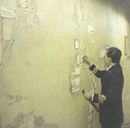
Thoughts about maps and spatial logic
"...Terms such as "mapping," "borders," "hacking," "trans-nationalism," "identity as spatial," and so on have been popularized in recent years by new media theories’ celebration of "the networks"—a catch-all phrase for the modes of communication and exchange facilitated by the Internet.
We should proceed with caution in using this terminology because it accords strategic primacy to space and simultaneously downplays time—i.e., history. It also evades categories of embodied difference such as race, gender and class, and in doing so prevents us from understanding how the historical development of those differences has shaped our contemporary worldview.
..." Read full article Questioning the Frame: Thoughts about maps and spatial logic in the global present by Coco Fusco, In These Times, December 16, 2004. Responses to the article culled from Locative and nettime:
Responses to the article:
Date: Thu, 16 Dec 2004 22:26:27 +0000
From: Pall Thayer
Subject: [Locative] Questioning the Frame
To: locative@x-i.net
hmmm.... I just wish she would mention some of the mapping projects she's talking about. She really seems to have a narrow understanding of what artists are doing with locative media. She seems to suggest that one of the problems is that the artists have too much control over the social picture that the maps portray. And other artforms don't? I'm going to have to read this through a couple of times to make sure I really understand what she's saying but after a couple of scans it really looks rediculous and I almost get the feeling that she regrets not being a "hacker".
Pall
Ewen Chardronnet wrote:
well, she always comes with interesting art critics and post-colonial discourses, but use same dialectics each time. I remember reading same dialectics in her critics on "art and science" hipe and "critical art ensemble trial" hipe. And now the "locative media" hipe... You can be sure there will be a critic on "pervasive arts" and "space arts" soon, etc. and of course better if those arts are done by white male artists
E.
Date: Thu, 23 Dec 2004 17:08:14 +0100 (CET)
From: Brian HOLMES
Subject: [Locative] A Reply to Coco Fusco
As a critic it's important to read your peers, and try to assess the pertinence of your own work in the mirror of theirs. So I was curious to read Coco Fusco's recent article on mapping [www.inthesetimes.com/site/main/article/ questioning_the_frame]. However, I must say that her continuous assertions of cultural authority leave me feeling highly ambivalent. On the one hand, the threads of historical memory she brings up are extremely welcome. On the other, her unwillingness to engage with current conditions and projects tends to reduce the past to a complaint: Why isn't it the present anymore?
It's true that the raw fact of being older than the majority of the people in a given crowd can make you feel uncomfortably lucid. When I went to a conference on so-called "locative" or GPS-based media at the RIXC center in Latvia, I found most of the projects quite naive, developing a few stylistic traits of situationist psychogeography in the absence of any geopolitical critique of power relations, or any philosophical critique of instrumental rationality. In effect, a Cartesian worldview has been built into the computerized technology of graphic information systems, which are undergirded by megaprojects of military origin, or what I call "imperial infrastructure." But rather than just giving a disciplinary lecture with all the answers stated in general terms, I tried to show how changing conditions had made the once-subversive traditions of psychogeography quite superficial, to the point where the aesthetic forms the artists were using seemed to render the very infrastructure of their projects invisible. And when I recently published that paper out of context in Springerin, I took the time to name all the artists and projects in question, so as to establish the precise referents of the critique [springerin.at]. I wish Coco Fusco would make that kind of minimal effort, as it would bring her sharp observations into contact with actual projects, and open up a space of possible transformation.
More to the point: When I began my work on mapping, about four years ago now, as a direct result of involvement in demonstrations against the policies of the WTO and IMF, I too felt that the most important reference was the history of the Third World movements of national liberation, in their relations to the Western civil rights and new left movements of the 60s and 70s. In an early text that was finally published in the book Moneynations, I tried to show how the very concept of the Third World, and then above all, the reality of the Movement of Non-Aligned Nations, acted to open up new imaginary and real spaces within the dominant bi-polar map of the Cold War [http://2002.memefest.org/en/defaultnews.cfm?newsmem=15]. I asked the question whether the emergence of the World Social Forum in Porto Alegre could be compared to the Bandung Conference in 1955. Obviously, the answer was that it could not: both because the current antisystemic movements do not (yet) have the strength that Bandung represented, and because the operative modes of opposition may well have changed fundamentally since 1955.
The global importance of the Third World movements lay in the new kinds of international solidarity that they helped provoke. But something important remains unstated in Fusco's references to these movements, and this is the fact that the major links that tied them to the First World do not exist anymore (nor, indeed, do the movements themselves, for we are talking about specifically national movements in the period of decolonization). One of these links was an aspiration to create a non-Stalinist form of communism, according to the examples given by the successful Cuban and Vietnamese guerrilla insurgencies, and also by Yugoslav self-management (one must remember that the non-aligned movement came officially into existence in Belgrade). Another powerful link was the notion of cultural authenticity, or inherent difference from the Western norm, as a liberating foundation upon which newly independent nations could be built. This Third World concept served as a basis for the struggles toward a multicultural society in the First World. Today, however, the egalitarian aspiration to a self-managed communism has no objective touchstone in reality, leaving those who feel its lack in a deep state of ideological disarray. At the same time, the notion of cultural authenticity has been largely usurped by nationalist or fundamentalist projects which, although they have fortunately not eradicated all work towards equal rights in a multicultural society, have nonetheless made it very difficult to raise the banner of cultural or ethnic difference as a rallying-point for international solidarity.
Instead of relying on the old internationalist slogans (Third Worldist or proletarian), the transnational movements of dissent that gathered strength throughout the 1990s tried to use the communicative power of the discourses of human rights that had gained currency in the 80s, largely through the resistance of people in the former Eastern bloc to totalitarianism, and in Latin America to dictatorship. It was subsequently necessary, in the late 90s, for the Western participants in these transnational movements to take the further step of putting their own bodies on the line, of taking direct action against the international economic institutions, in order to go beyond the abstract character of the human rights discourse. This was a way of responding, in the overdeveloped countries, to the sacrifices of the many "IMF riots" that had been held, often at great cost of life, in what was now being called the Global South. Anyone who believes this step was taken by middle-class white kids acting on internet fantasies, in the absence of direct input from social movements around the world, quite obviously didn't go to any of the demonstrations and paid no attention to the planning process or the reports.
The point, however, is not to suggest that a brief flare-up of worldwide protest has brought about any substantial change. It is rather to recall what a difficult and long-term effort is really needed, both to grasp the way that transnational state capitalism now functions, and to articulate large-scale resistance. When Josh On [www.theyrule.net] or Bureau d'Etudes [http://utangente.free.fr/index2.html] make their complex charts of contemporary power relations, one can be assured that the cold and abstract character of the results is very painful to them. I can testify, particularly in the second case, that they are acutely aware of what is missing from such documents: namely, some affective indication of resistance from below, who does it, how they work and why. What has been achieved in such cartography projects, however, is a contribution to the very large-scale effort to rebuild a critical grasp of the oppressive forces that create the dominant map of the world. This kind of power-mapping is a necessary prelude to any effective resistance or counter-proposition. The fact that the difference between such efforts and the current military maps used by the Pentagon does not appear clearly on American TV is hardly something you can blame the artists for! There is a difference between general culture critique and constructive critique directed toward people carrying out specific projects.
Somewhat like Coco Fusco, I often wonder why contemporary artists appear so broadly unable to infuse the dominant map with representations of - or even better, direct links to - the many and diverse dissenting groups and alternative philosophies that are now emerging in the world, or that have remained active over decades. Unlike Coco Fusco, however, I don't think it's useful or necessary to berate artists today for not having been born earlier. The great philosophical frameworks of national liberation and egalitarian self-management that were able to articulate far-flung resistance movements in the past are inoperative in our time. The urgency is for real individuals of all generations, on all continents, to put their heads and hearts together and create new articulations. The specific job of writers and organizers is then to give those articulations conceptual clarity and popular currency, so that they can effectively challenge the absurd world-views presented on American TV.
As to artists, for whom the naked power structures of the contemporary world must now be quite visible, I encourage them to delve more deeply into the diverse efforts that are being made to resist the imposition of a homogeneous control structure on the entire world. This requires looking outside the boundaries of class, ethnicity and nationality, as certain artists and intellectuals of previous generations effectively did. To live up to the great examples of the past then means imagining something quite different for the future. Need it be said that certain kinds of imagination can serve as the first steps towards a transformation of reality?
Date: Fri, 24 Dec 2004 04:13:32 +0000
From: Saul Albert
Subject: Re: [Locative] A Reply to Coco Fusco
To: Brian Holmes
Hi Brian,
I read both Coco Fusco's piece and your response with interest and a little bemusement. You addressed the lazy generality of CF's rant very well, and touched on a couple of things that provoked me to write back:
Firstly, can we please get away from technological determinism?
Yes, the use of military-industrial technology can be problematic, but that criticism in your text is as widely and as targetlessly applied as Coco Fusco's. Many people are using these technologies (GPS/mobile phones/internet/high-tech gizmos), the social movements that you use as your reference points as much as anyone. In fact, it's not like we really have the choice about using these technologies , being subjects in a technocracy... and it's only out of the appropriation and reuse of these technologies that critique can form and attempt to reconfigure the social and political relations that produced them in the first place. Even on a non-technical level, using these technologies and observing their effects and deployment has been instrumental in the development of a number of political discourses: information and affective labour, precarity, [cyber]feminism etc. The critique develops as much from practice as practice develops from critique.
example: London Free Map - http://uo.space.frot.org/?node=LondonFreeMap
http://chinabone.lth.bclub.org.uk/albums/misc/london_free_map.sized.jpg
Jo Walsh and Schulyer Erle have been working on the 'London Free Map' This project encourages participants to walk, drive, cycle or skate through city streets with GPS units and then use the 'traces' of points representing latitude and longitude that these devices generate to help create publicly licensed geodata. They are also working on adapting existing open source software to enable people to annotate and extend these maps in a very flexible way. The example linked to above shows straight lines representing GPS traces made wandering the streets of Limehouse, East London, an area undergoing a huge urban regeneration process in preparation for the proposed Olympic games in 2012. The labeled points are the locations and names of approved planning permission applications made to the London Borough of Tower Hamlets in the last five years, automatically retrieved from the council's website and plotted onto a scanned out-of- copyright historical map of the area from 1916. This is just one potential use of the London Free Map, a way of visualising physical and historical changes to a space undergoing a huge social and economic upheaval. The potential for further uses and the development of new, as yet unimagined maps from this project seems evident.
Secondly, I found the distinction between these technologically specific, less overtly political projects, and the 'power-mapping' practices of (the wonderful) Bureau D'Etudes and many many others to be a bit thin. I know you share their frustration at having to use the language of power to map power, but the problem is not just in the inability of this form to represent the fertile heterogeneity of the social movements. 'Power mapping' deals in the currency of power, and its representational structure can reinforce the dynamics of the relationships it represents. More worryingly, the unnerving coherence of these representations can also become ised easily - the currency of power made visual, or (worse) 'data visualisation' knits neatly into artistic and authorial currencies and relationships that can become as reactionary and totalising as the military-industrial technologies you were warning against earlier.
I know you know this, your descriptions of the playfulness of the Bureau's maps illustrates the path they choose out of this bind : 'solidarity with aliens'. But people using similar or derivative techniques seem to embrace the solemnity and darkness of their maps without having the escape pod provided by their humour.
What encourages me about initiatives like the London Free Map and many of the projects in the orbit of the 'locative media lab' is that they often work, on a very basic level, to avoid totalising representations. To some extent this is emerging as an informal agreement on technologies, open Semantic Web standards and other esoterica that I'm not really equipped to explain. Also, many of these projects are based on public workshops, working with people and groups on producing representations of themselves, spaces, movement and relationships. Of course none of this is inherantly interesting. Public workshops and 'open' technologies carry their own wealth of dead ends, vices and travesties, but they certainly are politicised - and politicising, in a very different and more subtle sense than that of 'power maps'. The contingency on input from the map-users is the most obvious distinction between these forms of mapping and the two examples of 'power mapping' you mentioned. Of course this aspect of 'participation' in the making of the map is just as worrying in terms of which currencies it evokes, auteurship and the 'framing' of 'public use' in the interests of pseudo-ehthographic artistic value creation etc. etc.. But the locative media lab's engagement with corporations, the way some of it is like cheap corporate R&D in exchange for getting to use fancy devices, the links with 'community groups' funded and instrumentised by arts bodies, and with governments for use of geodata is all messy, difficult, and suspect, but necessary if the technology, and the discourse are going to develop.
This probably warrants more examples, which I'm too tired to start with now.
I guess the problem is that criticising something is difficult because you have to explain why, whereas blithering pleasantries about things you like is not so demanding.
keep up the good work brian!
X
Saul.
Date: Sun, 26 Dec 2004 23:48:54 -0800
From: John Hopkins
Subject: Re: [Locative] A Reply to Coco Fusco
To: locative@x-i.net
>>Firstly, can we please get away from technological determinism? Yes, the use of military-industrial technology can be problematic, but that criticism in your text is as widely and as targetlessly applied as Coco Fusco's. Many people are using these technologies (GPS/mobile phones/internet/high-tech gizmos), the social movements that you use as your reference points as much as anyone. In fact, it's not like we really have the choice about using these technologies , being subjects in a technocracy... and<<
Why no choice? If no choice, isn't that technological determinism to the extreme degree?
It is an incremental process -- each mile you drive onwards in your fossil-fuel burning device, or crank open the thermostat in the house, that drives the social system further onward in its dominance. (it propels the US military machine a bit further in its desparate mission to secure the true power/energy-base of the social structure that is is an integral part of). each time you don't do those things de-poweres that same system.
each time you watch one minute of centrally organized media you give that structure more power. each time you cross social-structural boundaries and engage an Other human directly, you depower those ordained structures.
hmmm.
JH
Date: Mon, 27 Dec 2004 11:32:20 -0000
From: "Armin Medosch"
Subject: Re: [Locative] A Reply to Coco Fusco
Hi Saul, Hi Brian,
let me first make some sort of disclaimer: I am happy that Coco's article (which I have not read, but can roughly imagine what it contains) triggered this discussion about locative media which was long overdue. I think many people have felt uncomfortable with the unarticulated political 'content' or 'meaning' of locative work but have not spoken in public. One reason for that might be that they felt, as I did, that there is a lot of potential in that field and that the (mostly young) people involved did not deserve to be bashed for all their good intentions, even though those intentions sometimes gave relatively weak results. Finally the lid has been blown off and that is a good thing. I now do neither want to argue for or against Saul or Brian but just throw in my two-pence. I also have to say that writing something really meaningful about that whole area would take at least a day and I simply don't have that time right now. So please excuse the immaturity of my words which are quickly written in a sort of email improvisation which I guess was once the spirit of internet discussions which is now often sadly missed.
Saul said at the very beginning of his reply:
>> Firstly, can we please get away from technological determinism?
What does this statement mean? It is indeed important to 'get away from technological determinism'. But what this statement should not mean is that we should not consider or discuss technological determinism.
Saul continues:
>> Yes, the use of military-industrial technology can be problematic,
I would go further and say that 'can be problematic' is not strong enough. It _is_ problematic, always. The instrumental power that is contained in those technologies is a central issue of our time, and by 'our time' i do not only refer to the last couple of years or so but to the last 50 or even 100 years. Therefore I think such statements about technological determinism and military-industrial technology should not be used to quash any discussion about those issues. Those issues should exactly be the starting point of any discussion about 'locative' projects and indeed media art and net art projects. This is where the media art community has failed over the last 20 years which I was able to witness as a grown up person. It is one of the big failures of that community and possibly one of the reasons why it made so little real progress over that period of time. When I say 'real progress' I of course don't mean technological progress, of which we have seen plenty, but a progress in the social use of those technologies, in their accessability and applicability, in their ability to have an actual impact on the improvements of the situation of people.
I am arguing from a point of view of art that is based on a definition of art whose main reason to be is political. Such an art should be able to transcend the current power system. By 'transcending' i don't refer to metaphysics but to the actual socio-historic situation. In this situation and its projection of possible futures it should open up spaces, spaces for alternative ways of thinking, spaces that offer people different opportunities, for instance to realise alternative viewpoints outside the dominant system, or, more practically speaking, to be able to develop ways of resistance and at least limited ways of autonomy. Of course we cannot ask too much from art and the current level of oppression is so high, the ideology of technological determinism so deeply entrenched that it has become very hard to imagine anything that makes a real difference. But at least people should try. I am afraid I could not see that in most locative projects and in most of the discussions that have been had about the topic so far.
Most of the projects (I am aware that such generalisations without reference to particular projects are always lame but simply have not the time to go through bookmarks and list archives now) simply continue the master trope of the narration of hypermodernity, which is about expansion of technological mastery, coupled with economic growth, all under the banner of 'usefulness' for the people. This is how new communication technologies are being advertised. The mobile phone gives you freedom, it improves your social life, you can use it to form Rheingoldian Smart Mobs and if you put a little FOAF into it you can even realise alternative politicised virtual communities with it. Of course you can do all this stuff, it is even true. But by doing so, you are not leaving the established playing field, a field that has been established by the forces of techno-rationality in the service of capitalism.
I know it is a bit unfair to mention that here but the most significant 'locative' projects in that regard are Blast Theorie's mobile games. The critical content of those projects is nil. The whole thing blew up at futuresonica last year but most people could not read the signs on the wall. Of course their projects are resourceful, maybe well programmed, maybe even entertaining. But they are fundamentally affirmative of the world we live in and completely one-dimensional.
Now, to come back to the core question: it is simply wrong to ask if we are allowed to use military-industrial technologies. of course we should use them (and I do that by simply typing an email) but if we do it matters how we do that. do we contribute to the disguise of the political content of those technologies and thereby continue the positivistic narration of expansion and 'usefulness'? or do we use them to expose that which is always subconsciously present, that in this system, as Herbert Marcuse said 40 years ago, power is transferred into technological systems and that our dependency on those system makes us to their reified subjects? It is a general trait of this society that the powers that be try to cordon off the political. The positive side of things (technological things, gadgets, gps, pda's) gets highlighted but not what comes with it, not this hard to pin down element of power that has become nameless and faceless because
it has been inscribed in, is contained in the technological system.
Now, coming back to locative per se, I think Brian is right to say: "In effect, a Cartesian worldview has been built into the computerized technology of graphic information systems, which are undergirded by megaprojects of military origin, or what I call "imperial infrastructure."
Maybe he ment to say Geographical Information Systems (GIS). GIS combined with GPS and so forth truly signify the victory of Cartesian space over real space. Of course this victory is only a fake victory and never a final victory but it defines the current state of the arts in 'mapping'. Is it therefore forbidden for artists to use GIS? Of course not. The project by Jo Walsh and Schulyer Erle that Saul mentions, 'London Free Map' is a very good example. It is maybe not an art project but that does not matter. It tries to democratize GIS power, democratize in the sense of direct bottom up democracy and not fake vote rigging mind manipulating democracy (oh, that word, can someone suggest a better one?). It is experimental and utopian, it relies a lot on FLOSS and is probably difficult to use for people who are not tech-savvy, but that does not really matter at this point; it does not entertain in the way Blast-ed projects try to but that is effectively its strength. It involves fun, but of a different kind. We need more projects of this kind and we need a discourse that is better able to differentiate between projects that open up those other spaces and projects which simply fall into the technological deterministic trap.
I hope we can begin conversations that are critical and constructive and not about our personality disorders of which we all suffer to a certain degree, necessarily, because they are a function of that system we are subjected to. In this sense I agree that a lot of the 'psychogeography post-situationist' talk sounds naive. But at least it shows a desire to get away from Cartesian space and to reconceptualize the highly regulated spaces we live in. It makes a lot of sense to link FLOSS, art and the history and presence of liberation struggles, but that debate needs updates and rejigging too.
Hoping to be able to talk about those issues in a more elaborate way soon and also hoping to hear from other people now
regards
armin
Date: Tue, 28 Dec 2004 02:21:22 -0800
From: karlis
Subject: [Locative] Don't be shy
To: locative@x-i.net
...Executive Summary:
While studying locative media projects, a computer user realizes the value in talking to people.
Extended Commentary:
A romance of the aesthetic of the internet. Be somewhere, anywhere, it doesn't matter, "jack in" to the internet, and you're home, with your office and your contacts and connections. The presently inhabited city, be it Riga, Ljubljana, or Vancouver, is like wallpaper or decor in a restaurant. The principal interaction with the world is through the internet, and the information available there, the rest is somehow peripheral. So naturally when we approached the ability to make computing mobile and location aware, there seemed to be an answer of integration; finally the drift and nomadism would be informed and fulfulled with the power and potential of the network computer. All your revolutionary fantasies come true. Except the devices are retarded and complicated and expensive; they don't work properly, and they make you into a Steve Mann cyborg, someone more appopriately dressed for a mid 1990's DefCon hacker fair in Las Vegas than any part of life in public.
We tried to simplify the gear and determine what it was supposed to do, which was connect us to the network, make us contextually aware within that network, and informationally aware within that spatial context. The equipment had to be "naturally human", so that it is still possible to interact with the environment and the local culture without handicap.
No cyborg head displays or cybergloves, or star-trek tricorders. It also has to be inexpensive and uncomplicated and break-proof.
A beautiful natural language interface was developed (using selective evolutionary algorithms, no less). Billions of client terminals connected to a global information network have been deployed, planet-wide, that use this natural language interface.
They're called people.
Sitting behind my computer and obsessed with the internet for ten years, I totally missed the obvious connection that local people are connections to the whole network, the network of all information connections which includes the internet but also "old Joe Smith" with whatever he's got to offer. It's the same reason why I haven't needed a watch since I was 15 - someone around me always knows the time. The connection to the network is not limited to a GPS satellite signal reciever and a 2.4GHz wireless internet supercomputer laptop. Rather it's just a link to the next node with different information that what you can access on your own. The easiest, most locative way to access that network is by talking to people, and if these studies are urban, there's going to be people. Forget WiFi and GPS. Ask for directions. Ask the nearest person, or if you're aesthetically driven, ask the nearest good-looking one. If they don't have the answer, they might know someone who does, or can suggest an alternative. If they don't speak your language, they'll likely direct you to someone who does.
Maybe that's should be obvious. But as a bedroom caveman computer hack, to look around and find that this perfect system has already been implemented is amazing. It's multi-modal with multiple redundancies. Ubiquitous. Reliable. All-weather. Fuckable.
Maybe an internet legacy of the military paradigm has poisoned our preconceptions about the reliability and desirability of technology vs people. But if we are nice and friendly and not locally despised imperial soldiers, we don't have to bring all our knowledge in a computer. We can talk to the nearest person.
When I was in an busy new space I formerly looked around and saw great potential for overlaying great collections of information and data or media texture in location, if we could develop the system to realize it.
Now I see that this network is already in place, mobile info nodes are walking all around, ready to be engaged, connected to vast networks of people and information. Standard APIs. It's amazing. Sometimes you have to ask a bunch of times, even before you realize the right question to be asking. But if the information is there, someone has it, and you can find it.
The mention of technological determinism and political action, brought up in the context of locative media, seemed to make this "amazing" revelation relevant again. It has been called a serious political action to find ways beyond the gap between people in the very technically-focused and alienated population. Techno-fetish locative media projects made me realize how important and powerful it is just talking to people.
OK!
cheers
karlis
Date: Wed, 29 Dec 2004 14:15:32 -0800 (PST)
From: coco fusco
Subject:
In response to Geert's request, below is my commentary that was published in IN THESE TIMES recently. The comments were based on my lecture at the School of the Art Institute of Chicago in November, 2004. The series is entitled:
MAPPING / CULTURE / BORDER / HACKING /
and the school's description of the series is:
"This lecture series examines the work of artists, artist-collaboratives, and film/video makers whose works address or proceed from shifts in articulations of global culture, politics of the border and dilemmas of transnational or diasporic identities--identity as a spatial concern. Special attention will be given to artists who use the gesture and organizational logic of mapping, cartographic sciences and the grid to locate identity as well as its displacements."
I found this description so baffling and overladen with jargon that it prompted my response.
I have not had a moment yet to respond to Holmes's post. I found it a bit surprising that he would locate a response to an article in a left-wing Chicago newspaper on a list-serve with a primarily European readership (of his allies, I would add). A decision to locate his response HERE as opposed to THERE seems more like a rallying cry to his nettime readership than an address the substance of my argument or to the public in Chicago, a city with a long and venerable history of community and labor organizing, activist media, and radical black politics.
Coco
Posted by jo at 10:19 AM | Comments (1) | TrackBack
Envisioning the ubiquitous city

Control, Misuse, and Subversion
"...The rapid convergence of mobile communications, automated positioning technologies, and geographic information systems (GIS) into "locative media" is raising the possibility of a dramatic transformation of the way we perceive and move about the urban environment, and how we interact with each other in urban spaces. Endless possibilities for locative media are being proposed that promise increased convenience, awareness, transparency, and access to information and social opportunities that break traditional power structures.
Simultaneously, at this moment of realization of the potential of locative media, there is an emerging sense of helplessness at the potential for control, misuse, and subversion of these technologies. Whether by states or anti-state organizations like al Qaeda, locative media extend the ability of the powerful and mobile over the weak and immobile. Cross-referenced information through geographic tagging adds many more dimensions to the problems already raised by unchecked, widespread linking of relational databases in industry and government..." Read entire post by Anthony Townsend [and The Auto and The Mobile by Howard Rheingold].
Also, see Townsend blogs Wireless Public Space and Telecommunications: New Media and Cities.
Posted by jo at 10:01 AM | Comments (0) | TrackBack
December 27, 2004
netzwissenschaft
![]()
Emerging Infrastructures of All (Inter)net Research
Dr. Reinhold Grether's network research | netzwissenschaft site maps the "emerging infrastructures of all (inter)net research endeavours. net.science as an anthropology of connectivity is trying to overcome the constraints of specialist method transfers on net matters. the protuberance of technical networks necessitates a professionalization of human net knowledge. neither the isolation of concepts as in basic research nor the encapsulation of processes as in applied sciences will ever be able to adequately describe the complex autopoiesis of networks. net.science is undoubtedly developing into a scienza nuova of its own right."
Check out his Mobile Art and Virtual Performance research areas.
Posted by jo at 04:45 PM | Comments (0) | TrackBack
December 24, 2004
Art Mobs

Creating a Meta-Dialogue
The Art Mobs project, created by Dr. David Gilbert and students from Marymount Manhattan College, allows users to share their art experiences using a mobile phone or iPod.
Using the text messaging features of mobile phones, users leave comments about works of art for others to read. With an iPod, users listen to guided tours of art exhibits created by anyone who has an opinion about the show. Users are also invited to make their own tours for others to listen to.
The project should be lauded for encouraging people to be more active when attending art events in galleries and museums. The Art Mobs project takes advantage of the widespread use of mobile phones and portable MP3 players, making them devices for distributing information and connecting gallery goers, which is a nice counterpoint to the frequently-posed argument that these devices are socially isolating.
Watch a demo video here.
Posted by MK at 12:17 PM | Comments (0) | TrackBack
December 22, 2004
Real Remote Guided
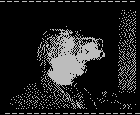
Controlled by web users
Real Remote Guided, by Antonio Lomas, features a subject who is "blinded" while the spectators / speakers on the internet and in the physical space, are able to see what the subject could see in normal circumstances.
GPS and web cam are combined with a laptop linked to the net through telecomunicaton systems (cellular telephony and/or wireless).
On the web page, the web guides see the images from the camera worn by the artist, as well as map images that define his location so that they can send him instructions, guiding him through a space of real intervention. The artist can only see the instructions sent by the users and the map images of the GPS system.
The idea is to represent, in a playful way, how new technological systems can take control. So, spectators are invited to take that control and to manage it.
Posted by Regine at 03:01 AM | Comments (0) | TrackBack
December 19, 2004
Disembodied Voices
![dv1_clip[2].gif](http://www.turbulence.org/blog/images/dv1_clip[2].gif)
Irritating mobile phone conversations
"Disembodied Voices", by Santa Monica-based artist Jody Zellen, leads the viewer through a series of experiences exploring the global phenomenon of cell-phone conversations, those half public, disembodied conversations have become a ubiquitous irritant in our society.
Five dynamic animations fill the walls. Four of these animations are DVD projections that depict individuals moving through public spaces, unaware of their surroundings because they are intent on their cell-phone conversation. At the bottom of each projection are fragments of text that represent the monologue. The texts intersect physically as the viewer reads across them. The fifth projection is connected to a computer and contains the interactive component of the installation. Visitors to the space trigger a series of sounds by interacting with 'toy' cell-phones that hang from the ceiling. All the buttons on the phones are programmed to trigger an event on the wall. Using the 'toy' phones causes the icons on the wall to grow from their diminutive silent state to a larger brighter version with sound. The voices reflect the global nature of cell phone usage as the conversations take place in numerous languages: French, Spanish, Japanese, Indonesian, Cantonese, as well as English. When all ten phones are active the experience is a sound collage, a cacophony of overlapping icons and voices. (via rhizome)
Posted by Regine at 02:34 AM | Comments (0) | TrackBack
December 18, 2004
The Living Room

A narrative installation puzzle
"The Living Room", by American artist Victoria Fang, is a narrative puzzle installation. Players enter a space containing 3 rolling units with screens in them and 21 clues painted on the floor. They have to move panels with LCD monitors to solve a whodunit murder mystery. Correctly positioning the units triggers filmed scenes that play back across the three separate panels, and these scenes give the player new clues to trigger the next scene. Players get a different spatialized experience with each scene, as the scenes are constantly changing position, thus working as a giant physical puzzle that houses a narrative puzzle.
This project is designed as an entertainment experience that focuses on the cathartic release of built-up emotional tension, through the use of mobile and wireless technology.
"The Living Room" has received a nomination for Transmediale award 2005.
(PDF of the project)
Posted by Regine at 12:31 PM | Comments (0) | TrackBack
December 14, 2004
Where on-line meets on the streets:
experiences with mobile mixed reality games
"We describe two games in which online participants collaborated with mobile participants on the city streets. In the first, the players were online and professional performers were on the streets. The second reversed this relationship. Analysis of these experiences yields new insights into the nature of context. We show how context is more socially than technically constructed. We show how players exploited (and resolved conflicts between) multiple indications of context including GPS, GPS error, audio talk, ambient audio, timing, local knowledge and trust. We recommend not overly relying on GPS, extensively using audio, and extending interfaces to represent GPS error." From M.Flintham, R.Anastasi, S.Benford, T.Hummings, A.Crabtree, C.Greenhalgh, T.Rodden, N.Tandavanith, M.Adams, and J.Row-Farr (2003). Where on-line meets on the streets: experiences with mobile mixed reality games. In Proceedings of the conference on Human factors in computing systems, pages 569–576, Florida, USA. [via pasta and vinegar]
Posted by jo at 02:53 PM | Comments (0) | TrackBack
December 09, 2004
Summoned Voices
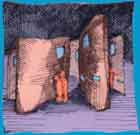
Interactionfields
Summoned Voices--by Iain Mott and Marc Raszewski--acts as a living memory of people and place. It consists of a series of door installations each with an intercom, sound system and a computer that is networked to a central file and database server. The design metaphor of the door presents a familiar scenario, that of announcing oneself at a doorway and waiting for a response from persons unknown. Signage instructs the public to speak, make sounds or sing into the intercom. Their voice is stored and interpreted, and results in local playback composed of the individual's voice with those that have gone before. Summoned Voices acts as an interpreter of sound, a message board and an imprint of a community - a place for expression, reflection and surprise.
Summoned Voices is one of the 22 projects catalogued by Mirjam Struppek for her thesis Interactionfield - Public Space in the Digital Age (2002): "The public space is a field, which is created and becomes alive through various forms of interaction.
Thus interactive art with its life proximity, communicative issues and reflection of the power of the modern technologies is well suited to be linked with the urban public space. This information platform presents detailed some selected interactive media projects, which went consciously into the urban public space. The analysis, categorization and questionaire with the producers of these 22 examples show how new media can be alternatively used, in order to contribute to the rediscovery and reactivation of the urban space and to lead to new interaction qualities. In the open expandable list further projects are collected. With the time an archive can develop, with examples, that show new ways in dealing with the public space. The links section presents various conferences, research projects, articles and specialized artists that related to this topic."
Posted by jo at 06:36 PM | Comments (0) | TrackBack
msdm
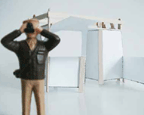
researching mobile strategies of display & mediation
msdm [mobile strategies of display & mediation] is an imaginary organisation founded in 1998 by paula roush to research mobile strategies of display & mediation. A hybrid of artistic, curatorial, experimental practice operating in the interstices of institutions and social systems, the organisation aims to propose participatory alliances for transversal, critical, cultural and aesthetic outputs. The collaborations have extended into the domains of open source software, publishing, para-architecture, public signage, radio streaming and mobile media platforms. They have been shown in galleries, museums, non governmental organisations and independent spaces, including Space Studios, Coleman Project Space, The South London Gallery, the Institute of International Visual Arts, the Bauhaus Foundation, Gesellschaft fur Aktuelle Kunst and the Living Art Museum.
Projects include:

geneticSilence: Public intervention and installation at the Living Art Museum in Reykjavik for the project Polyphony. A bus tour -the ’genetic noise tour’- was organised connecting the gallery with the street. The initial proposal was to have it to collect tourists in the city centre and take them on a tour of the high security genetic labs in the surroundings of Reykjavik. Because the right bus could not be found, the project took another shape and the tour was done in a small VW van, with the tech crew streaming the sound and images to the museum. The accompanying wall catalogue and public newspaper boards showed an archive of the links between art, genetics and architecture. The word ‘art’ -privatised by a genetics research company- was ‘corrected’ in the museum signage with the corresponding patent number.

bowville: bow wireless/ space studios/ london; locative media performance, 2004. Marion Manesta Forrester was electronically tagged. She had 3 days to earn her right to become a citizen of Bowville. People had to vote for her to stay or to go by phone, online or in person by visiting the Bowville Investigation Bureau. Download Bowville Booklet, 9 pages (pdf, 656k) or individual pages at higher resolution : page 1 | page 2 | page 3 | page 4 | page 5 | page 6 | page 7 | page 8 | page 9 |

SOS:OK: A work generated in response to Biscuit Town, the name given to the area surrounding Peek Freans biscuit factory. Biscuit Town was a marker in both organisational and representational forms of labour. It was the first mass producer of biscuits and commissioned the first documentary film shot on location (A Visit to Peek Freans, 1906, BFI Archive). At its core there is an artistic intervention that crosses a gallery installation with a public art intervention. The aim is to produce an emergency biscuit in response to the history of the site (Peek Freans was the first factory to manufacture an emergency biscuit ration to feed the starving population of Paris during the Franco-German war 1870-71) and the current international state of emergency. The launch and the time based performance at Coleman Project Space is inserted into a wider public campaign which includes billboards.
Posted by jo at 05:44 PM | Comments (0) | TrackBack
Are cell phones new media?

re-narrating cities via nomadic technologies
"Multiuser environments in cyberspace have frequently been regarded as utopian spaces in which users could project their imagination. When communities are shaped in a hybrid space, mobile phones become new media tools for creating novel and unpredictable imaginary spaces, re-narrating cities. Fixed Internet users do not have the ability to move through physical space. But the emergence of nomadic interfaces represents a chance for such imaginary spaces to be enacted and constructed in physical space.
Nomadic technologies have a twofold role in the construction of playful/narrative spaces. First, they allow virtual spaces to be mobile, bringing them into the physical world. Second, when used to play games, they free the game from the game board or the computer screen, making it possible to use the city space as the game domain." from Are cell phones new media? by Adriana de Souza e Silva [Related]
Posted by jo at 12:44 PM | Comments (0) | TrackBack
December 03, 2004
Interactive portrait of the Liberties

interactive narrative environment as navigable architectures
The Interactive portrait of the Liberties--by Valentina Nisi--is an interactive digital narrative application developed in conjunction with the Trinity College/MediaLabEurope CARMEN HCA founded project. The vision is to provide multimedia content to individuals and to groups, which is relevant to them at a particular point in time and space – in other words, context-aware. The delivery platform for multimedia application will be the WAND infrastructure: a collection of wirelessly connected nodes linking Media Lab Europe with Trinity College where content and services can be stored. The WAND infrastructure and the CARMEN middleware and software will allow stories, collected from local community members, to be distributed in the space and physically navigable taking literally the metaphor that describes interactive narrative environment as navigable architectures. Example.
The stories will be available to the users as they walk around. A database of many short self-contained stories is put together following the themes of locations, social networks within the community members and a family genealogic threes. Location, social network, user profile are some of the variables that come into play when talking about context aware stories. Depending on the changing variables many different combinations of the story elements can result from the viewer navigation of the area.
The stories have been researched and collected by making contact with local community members and through books with a strong emphasis on the social and folkloristic aspects of the area, such as Mairin Johnston book “Around the banks of Pimlico” and Leo Mhonogan not yet published photographic collection about the liberties. Some ethnographic interviews have been conducted during the summer that revealed a rich baggage of stories and traditions which make the liberties area an ideal location for this type of project.
Posted by jo at 12:21 PM | Comments (0) | TrackBack
Augmented Space
"GPS, wireless location services, surveillance technologies, and other augmented space technologies all define data space – if not in practice than at least in their imagination - as a continuous field completely extending over and filling in all of physical space. Every point in space has a GPS coordinate which can be obtained using GPS receiver. Similarly, in the cellspace paradigm every point in physical space can be said to contain some information that can be retrieved using PDA or a similar device. With surveillance, while in practice video cameras, satellites, Echelon (the set of monitoring stations which are operated by the U.S. and are used to monitoring all kinds of electronic communications globally), and other technologies so far can only reach some regions and layers of data but not others, the ultimate goal of the modern surveillance paradigm is to able to observe every point at every time. To use the terms of Borges’s famous story, all these technologies want to make the map equal to the territory." From "The Poetics of Augmented Space: Learning from Prada" by Lev Manovich.
Posted by jo at 10:49 AM | Comments (0) | TrackBack
mobile_connections

SPACE
mobile_connections explores how geographical, cultural and perceptual space are being reconfigured by wireless and mobile media, and looks at the diverse ways in which artists are pushing the limits, and soliciting unexpected or unforeseen results, from communication media past and present, from the radio to mobile telephony and wireless LAN.
mobile_connections is the media art strand of the futuresonic04 festival of electronic music and media arts, and also involves satellite events at other international events in the lead up to the festival. It was devised by loca.
Posted by jo at 10:18 AM | Comments (0) | TrackBack
December 02, 2004
Teri Rueb's four questions
Four very good questions on locative media posted on the Location_Focus list (blogged below), reblogged by Martin Rieser on Mobile Audience:
From: Teri Rueb
1) Community and site-specific practices of the 60s and 70s emerged in large part from artists concerns about circumventing the elitism of the gallery/ museum system and addressing issues of representation and participation in shaping and interpreting the cultural landscape. Whether or not communities / sites have been meaningfully and responsibly engaged in such practices remains a central concern in evaluating their impact. How do you see emerging practices in locative media relating to and carrying forward this history - or do they? Has this historical connection been adequately examined? What role does the technology itself play in locative media practice? Is it critically engaged or does it more often tend to upstage or eclipse social concerns inherent in such practice?
2) The mobile phone is often envisioned as the ideal delivery platform for locative media works due to their ubiquity and general accessibility. Even where bandwidth via mobile phone becomes an issue (in the case of video or sound), shifting the focus to alternative hardware platforms such as PDA or pocket PC still requires a contractual relationship with the phone company or ISP for connectivity. In each case, a tremendous amount of power and profit is placed in the hands of the phone company as content delivery potentials expand with locative media. Can we envision ubiquitous/accessible delivery systems that don't leave the phone company holding all the cards? Can policy dictate the equivalent of a "public access" channel, or percent-for-art model equivalent for locative media that relies on network connectivity? Are there alternative solutions that can maintain the vision of universal access when it comes to mobile connectivity?
3) Where might locative media take us in terms of cognitive and proprioceptive ability and awareness? What kinds of cognitive processes are engaged by or emerge from interaction with locative media? For example, in my own work I have used sound overlays only - no screen-based, visual content delivery. This is partly because I believe that audio is a more appropriate mode of information delivery when dealing with the mobile subject where eyes and bodies are typically already engaged in navigating and taking in the surrounding environment. However, I am open to the possibility that we might adapt to multi-modal interfaces as they become more pervasive. For example, it was originally thought that putting a radio in a car was dangerous - but very quickly a radio became an essential part of the standard dashboard.
4) How do locative media re-invigorate practices associated with predominantly oral cultures such as the fixing of information in memory based on place (as in ancient and classical mnemonic arts) and movement (as in Aristotle's peripatetic school) or the spatialized narrative of aboriginal walkabout or the medieval bard? Can Walter Ong's notion of secondary orality be meaningfully applied to this area of inquiry?
See answers.
Related: Sabine Breitsameter's interview with Teri Rueb on Audiohyperspace
Posted by jo at 11:58 AM | Comments (0) | TrackBack
Mobile Games
Research on location-based mobile games
Adriana de Souza e Silva is a Senior Researcher in the UCLA Graduate School of Education and Information Studies, where she studies mobile communication technologies, "focusing on how these devices change social practices and the experience of urban spaces by means of location-based mobile games."
Her 2004 PhD dissertation (pdf) on "nomadic technology devices and hybrid communication places" looks particularly interesting:
"This dissertation addresses how mobile communication technologies, with a focus on cell phones, have an active role in creating new types of communication and social networks in a hybrid space formed by the blurring of borders between physical and digital spaces. It analyzes the transference of social places from cyberspace to hybrid spaces. Nomadic technology devices are responsible for producing new social networks in a space that interconnects the physical and the virtual due to their users’ perpetual mobility ... Nowadays, the constant connection to virtual spaces, allowed by new mobile communication technologies, transforms our social spaces, as well as the projection of our imaginary places in urban spaces..."
Originally blogged by Anne Galloway, purselipsquarejaw
Posted by jo at 11:00 AM | Comments (0) | TrackBack
Mobile Confessional

Broadcasting Sin
The scenario of the Mobile Confessional is as follows: when you see the vehicle (called projectCAR) while stuck in traffic, you can call in to hear the message: "Welcome to the Mobile Confessional. Our service provides callers a safe and anonymous place to confess their sins to the world while commuting in Los Angeles. Your confession and an appropriate penance will be scrolled across the electronic sign in the back of the mobile confessional vehicle. Please, take a moment to share your sins with the world, so that all may forgive you."
This is only just one of the projects of Design and Technology for Mobile Experiences that tries to understand how design and technology can create compelling mobile experiences.
You are invited to attent final presentations and guest critique for the Interactive Media Division Graduate Seminar Design and Technology for Mobile Experiences, Monday December 6th from 10am-12n in the Zemeckis Media Laboratory, Los Angeles.
This modern way to make confessions reminded me of a project of Louise Wictoria Klinker and Andrea Berlinger (students at the Royal College of Art in London): the remote confession kit for catholic priests.
Originally blogged by Regine at near near future
Posted by jo at 09:01 AM | Comments (0) | TrackBack
November 23, 2004
global compatibility/mobile conectivity
The possibility of global compatibility and portable, mobile connectivity may not be right around the corner, but it's on its way.
In the Monday, November 15 issue of TheFeature, David James writes that the South Koreans, long leaders in adopting and developing mobile communications, will soon be testing their mobile broadband access system, WiBro (wireless broadband) and that WiBro will be the first country-wide network to serve as a testing ground for what may become the leading international technology for mobile broadband: mobile WiMAX.
"WiMAX is the name now given to that set of technologies sponsored by the WiMAX Forum and based on the Institute of Electrical and Electronics Engineers’ 802.16 family of technology standards for broadband wireless access. IEEE 802.16 is for fixed access, and 802.16e is for mobile access. Both use a form of OFDM transmission, rather than CDMA. The objective of WiMAX and its supporters is to promote global compatibility and inter-operability of broadband wireless access equipment for fixed, portable and mobile connectivity."
There's a lot of testing ahead but Korea plans to begin a commercial service in 2006. For more, see "The Road to Mobile Broadband Runs Through Korea"".
Posted by newradio at 09:14 AM | Comments (0) | TrackBack
November 22, 2004
SoundPryer

Truly Mobile Joint Music Listening
Mattias Östergren and his colleagues at the Interactive Institute in Stockholm are designing wireless software for mobile music "socials." But the dance parties they envision take place at 55 miles per hour. SoundPryer is a wireless peer-to-peer system for joint music listening in automobiles. Each driver becomes a mobile radio station, transmitting their digital music stream to other cars within Wi-Fi range.
SoundPryer has similarities to tUNA, a handheld ad-hoc networking radio device demonstrated last year by Media Lab Europe that enables users to tune in to other nearby digital music players, on a school bus for example. And while the PDA-based SoundPryer system can also be used in more stationary face-to-face situations, Östergren purposely kept his eyes on the road when designing the system. First of all, he writes in a scientific paper (PDF), it's a tougher challenge than more stationary systems. The potential duration of interactions between drivers may be extremely short as the cars zip down the highway or, in the event of gridlock, painfully long. The freeway is also a decidedly anonymous zone, perfect for studying how people might react to a new social technology.
From "Wireless Music's New Social Sound," by David Pescovitz, theFeature
Posted by jo at 05:30 PM | Comments (0) | TrackBack
November 15, 2004
Mobile SCOUT

"Our Automated Quirky Naturalist"
Mobile SCOUT A Mobile Phone and Web Public Art Project by Julian Bleecker, Scott Paterson and Marina Zurkow: are you in a concrete jungle or swamped by tourists? Who's around you, what do you see? A deer, a dump or a daydream? Saintly acts or sinful facts? Mobile SCOUT is a public art project that collects audio narratives of your local surroundings, personal rituals and public sightings. Using your mobile phone, you leave a voice message of your observations with the Mobile SCOUT Ranger, our automated quirky naturalist.
Turn your observations into a brief message about the flora (landscapes), fauna (characters) or behaviors (events) that populate your surroundings. Call the Mobile SCOUT Ranger - 1 (877) 564-3060 - he will guide you through the experience. [via]
When you call you'll:
* pick your mission (flora, fauna or behavior)
* pick two habitat attributes
* leave a recording
Further instructions for operating Mobile SCOUT are available at our online brochure. Mobile SCOUT defines place as being made of social habitats, not geography. Your recordings are organized into an audio/visual field guide according to the kind of space you occupy, be it play, work, nature, culture, public, private, branded or free speech. See the field guide and listen to recordings left by others by visiting the web site.
Mobile SCOUT was commissioned by "The Database Imaginary", an exhibition at the Walter Phillips Gallery at The Banff Center, and curated by Sarah Cook, Steve Dietz and Anthony Kiendl. Mobile SCOUT was produced with support from BeVocal for voice application hosting.
Posted by jo at 11:21 AM | Comments (0) | TrackBack
November 11, 2004
Kiosk Correspondance
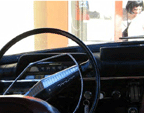
remote-live-networked-interactive-performance
Kiosk Correspondance November 14, 2004, 18:00 - 21:00: Get the facts of gilbertandgrape's whereabouts and mischief in Kiosk Correspondance at the East End Collaborations festival and online. Give us a cassette, a song of romantic significance to play in the Volvo; you can drop it off at the gilbertandgrape office installation at the EEC or email us a suggestion. Kiosk Correspondance is a remote performance with an online connection, and uses phone conversations and live documentation.
Between 2004 and 2008 GilbertandGrape and their lone ranger, a 20 kilo stuffed moose head, will travel the coasts of England and Norway in a Volvo Amazon to search out and collect stories from people with an interest in nostalgia, document vague memories, exchange taped music and watch sunsets at the end of the day.
East End Collaborations 2004
Saturday 13 and Sunday 14 November
an intensive weekend of new work by new artists
Queen Mary, University of London,
Mile End Road, London E1
Venue: The Arts Building, Queen Mary, University of London, Mile End Road, London E1 4NS. (between Mile End and Stepney Green Tubes).
The EEC Platform is an opportunity for emerging practitioners from across London to present new performance and time based works and an invitation to audiences to experience the artists of tomorrow today.
Tickets: £5 (£3 concessions) per day or £8 (£6 concessions) for a 2 day pass.
Bookings: 020 7882 5196
Concessionary tickets are available for wheelchair users and an accompanying person. Please indicate at time of booking any special requirements, wheelchair space or any other mobility assistance. The theatre and other performance and installation spaces do not have hearing induction loops.
Posted by jo at 08:38 PM | Comments (0) | TrackBack
Receiver
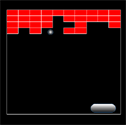
The new issue of Vodafone’s RECEIVER has been released. Content:
* Erkki Huhtamo: Hidden histories of mobile media * Tim Clark: Mobile communications and the wireless internet – the Japanese experience * Amparo Lasen: Affective technologies – emotions and mobile phones * Mike Butcher: Rewind -fast forward-play – mobile Napsterisation * Barry Wellman: The mobile-ized society – communication modes and social networks * Drew Hemment: The telephone exchange * Adam Greenfield: Along the fault lines – designing for deception, dishonesty, and other happy facts of human nature * Cory Doctorow: Eastern Standard Tribe – a story about love, death and cellular telephony * John Chasey: The future of mobile gaming – multiplayer games.
Posted by jo at 10:18 AM | Comments (0) | TrackBack
Utopia Travel
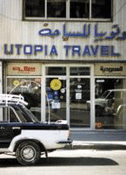
A Journey in Search of (post)modern Utopia
Utopia Travel is a collaborative project by Austrian Artists David Rych and Emanuel Danesch. The basis of the project is the transport of a video collection from Cairo to Vienna, following the transition from the upper part of the African continent over the Middle East towards Europe. An Egyptian taxi equipped with a video monitor served as a mobile unit distributing the contents of the video-archive on the distances between the capitol cities of the respective countries.
The title of the project was taken from the name of a travel agency in Cairo, which befittingly alluded to the ironic circumstance that tourism offers a temporary utopia of exoticism in various directions, whilst discovering no more than just a transmitted fragment of another culture. The archive contains pre-selected video material produced by artists/ film directors originating from and in most cases living in one of the countries on the route.
Every single videotape is labelled with the name of the author and title of the work. The only indication marking region on the label, is a colour code, created by melting the colours of every national flag into one. Since in certain regions (like the states of former Yugoslavia) the colours of neighbouring nations remain quite similar, differences are visible only in very subtle nuances; this makes people guess the precise origin of a work, even if the basic region was quite obvious. The method of presentation provided the opportunity to touch on a variety of issues, from the complexity of individual societies to the construction of political territories. In that sense the project is understood to be a temporary, non-institutional platform focusing on the translation and transmissibility of local cultural codes as different aspects of interrelated history.
The Archive was shown in the taxi as a mobile video installation on a three and a half months long tour through the cities Cairo, Beirut, Istanbul, Sofia, Belgrade, Sarajevo, Zagreb, Ljubljana, Graz and Vienna. The presentations took place to a large extent in public space, while also docking to different institutions for art and culture.
Posted by jo at 10:04 AM | Comments (0) | TrackBack
November 09, 2004
Anxiety, Comfort, and Play in Public Places

Wireless Technology and Social Re-appropriation
Familiar Strangers: Anxiety, Comfort, and Play in Public Places by Eric Paulos and Elizabeth Goodman: The Familiar Stranger is a social phenomenon first addressed by the psychologist Stanley Milgram in his 1972 essay on the subject. Familiar Strangers are individuals that we regularly observe but do not interact with...While today’s mobile communication tools readily connect us to friends and known acquaintances, we lack mobile devices to explore and play with our subtle, yet important, connections to strangers and the unknown – especially the Familiar Strangers whom we regularly see. Will these systems provide a new lens to visualize and navigate our urban spaces? How will these systems provide an interface to strangers and unknown urban settings? What will such devices look like? How will we interact with them? What will they reveal about ourselves and strangers? Will they alter our perception of place? Of the strange and unknown?
Posted by jo at 03:13 PM | Comments (0) | TrackBack
Location-based mobile phone games
IN-duce published a list for mobile phone games using GPS or cell towers signals, there's also a lists of other location based (or augmented reality) mobile games.
Originally from The Invisible Rabbit, reblogged on near near future.
Posted by jo at 01:03 PM | Comments (0) | TrackBack
November 06, 2004
DIALelbarrio
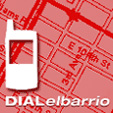
Neighborhood Archives
DIALelbarrio is a project that uses blog technology to build and distribute an audio and image repository of stories about the neighborhood of El Barrio. By allowing users to participate by simply dialing their own mobile device, the project seeks to make contributing information about the neighborhood, its people, places and histories as convenient as making a phone call. DIALelbarrio is part one of a larger wireless project that will make the rich legacy of East Harlem known to all in the Fall of 2004.
Posted by jo at 10:15 AM | Comments (0) | TrackBack
November 01, 2004
Augmented Reality

The Eyes Have It
Augmented reality is about taking real things and real places and adding a layer of computer generated information on top of them. In the Thursday, October 28, 2004 Feature article: The Eyes Have It by David Pescovitz, you can read about how tomorrow's mobile phones may project the wireless web right into your eyeballs.
As a near-sighted person sensitive to to the glare of sunlight, this sends shivers through my retinas, but the commercial issue is space -- mobile screens are small and, as Pescovitz says, "there's not much room for expansion inside your pocket", so virtual retinal displays (VRD) are in the developmental stage.
"The small screens and narrow fields of view of mobile devices don't work well with the human vision system," Professor Thomas Furness, director of the Human Interfaces Laboratory, says. "When we first started talking about VRD, the idea was to create a system that requires very little power but can be connected to a PDA or cell phone to deliver a wide field of view with high brightness. For mobile computing applications where you want to overlay digital information on top of what you see, you need the luminance to compete with the outside world."
Augmented reality--computer-generated data superimposed on the real world: You can walk around the city with information about everything you see, passing before your eyes.
Posted by newradio at 11:17 AM | Comments (0) | TrackBack
October 28, 2004
MapTribe
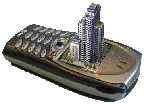
A tool for collaborative mobile learning
MapTribe is a software application for mobile phones. It enables group of users to see each other's position on a city map on the screen display, and to add on this shared map a certain number of objects that will positioned on the map according to the user's real position in the city.
MapTribe is based on the idea that every person retains and develops over time an image of the spaces s/he lives, which may be quite different from the physical inhabited place. It is commonly experienced, in fact, that places are enriched of psychological features that transform their perception. MapTribe is a tool for exchanging and comparing these personal images of the city among a group of friends. The tool we are developing helps people in analysing, capturing and visualizing this mental structure and to share it in a social network. From the negotiation of the differences between the maps of each participant in the group, a common understanding raises, an informal learning obtained by each user of the system about the image of the city.
Posted by jo at 10:37 AM | Comments (0) | TrackBack
Cell Phone Drum Machine

Collaborative Rhythm Generator with an SMS Interface
Cell Phone Drum Machine is a rhythm generator that can be controlled by users with their phones by sending text messages. Here's how it works: the operator links his/her phone to the computer and starts the drum sequencer. Users can then send special SMS commands to the operator's phone that controls the rhythm. The on-screen display shows from which phones commands originated.
Matt Hall and John Watkinson will present the project at dorkbot-nyc on Wednesday, November 3rd, 7pm at Location One in SoHo.
Posted by jo at 10:08 AM | Comments (0) | TrackBack
RE-PUBLIC

Drama, Mediation, Performance and Mobile Games
Intermedia at the University of Oslo has an interesting project about mobile gaming. RE-PUBLIC is a project that deals with humanistic perspectives on emerging digital communication forms & expressions & their information systems.
What are the dramaturgical and mediational features of commercial mobile games? Do location sensitive, always online, portable gaming terminals change the dramaturgical and mediational features of commercial mobile games? How will such terminals interact with ubiquitous computing in the physical environment to create new forms for hybrid games? How and to what extent are the less pre-scripted qualities of mobile and context-related play realised textually and interpersonally? How can the humanities inform and perform ICTs and vice versa? What can the study of computer games tell us about performance and the obverse? How can performance influence the design of computer games? What kinds of performances emerge in multi-player role-playing games?
Originally from pasta and vinegar, reBlogged on Clippings on October 27, 2004
Posted by jo at 09:29 AM | Comments (0) | TrackBack
October 25, 2004
Mobile Technologies and Wireless Networks
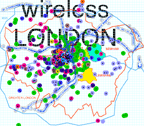
WORKSHOPS at SPACE
Workshops will be run by SPACE's Media Technologies Specialist Peter Chauncy in partnership with practitioners working in related areas. Workshops will cover the following:
Thursday 18th November: Wireless Free Networks - desktop 2 rooftop Omni Directional Antenna Building; with James Stevens from Consume.net
Tuesday 23rd November: An Introduction to Wireless Networking-A Wireless Rig; with Psand
Thursday 25th November: Portable Devices - iPAQs, mobile phones and GPRS; with Giles Lane from Proboscis
Monday 29th November: Locative Media - Global Position System (GPS) devices; with Ambient TV
Each workshop will include:
*An introduction to the technology
*Examples of practice
*Discussion around related concepts and critiques
*Instruction in using equipment and an opportunity to test it
All workshops cost 25UKP and places are limited.
To apply please contact Marina or Paul on 020 8986 5998 or email
spaceplace @ pacestudios.org.uk
Places will be allocated on a first come first serve basis
All workshops will be held at SPACE Triangle, 129 - 131 Mare Street, London E8 3RH Workshops will all run from 10:30 - 17:00. Please advise us where possible, if you're going to be late. SPACE Triangle is fully wheelchair accessible.
Please let us know if you have any other access requirements.
For more info check out:
Bow Wireless http://www.bowfestival.org.uk/Bow_wireless.htm
The State of Wireless London by Julian Priest
http://www.ambienttv.net
http://www.proboscis.org.uk
http://psand.net/
http://www.consume.net
Marina Vishmidt/Paul Gardiner
Media Arts Administrators
Space Place
43-45 Dace Road
Fish Island
London E3 2NG
Tel: 020 8986 5998
Fax: 020 8986 6887
email:spaceplace @ spacestudios.org.uk
http://www.spacestudios.org.uk
Posted by jo at 12:58 PM | Comments (0) | TrackBack
October 21, 2004
Malleable Music

Social tech is performative
"...Malleable Mobile Music system is my idea of truly social (i.e. performative) mobile tech.
"'Historically, music was never meant to exist in isolation,' Tanaka says. 'There was always a physical, acoustical, and even social context. These kinds of technologies can add some of those elements back in to the listening experience'...As one participant naturally sways to the groove, the PDA's motion sensor detects his motion and shifts the tempo of the song. With the song's intensity building, another listener subconsciously grips her PDA tighter, introducing echo effects into the mix. The closer that listening partners move to each other, the more prominent their part in the song becomes. Meanwhile, the software applies various 'error correction' techniques to prevent an onslaught of arrhythmic noise, unless of course that's the goal. As they listen to it, the mobile music orchestra transforms the tune into a dubby, spacey version of the familiar Bjork song...Someday, malleable music may even become an art form in its own right, leading to a duet between the artist and the audience."
Check out the Ubicomp 2004 paper for more detail. Originally posted by Anne Galloway on purse lips square jaw.
Posted by jo at 11:43 AM | Comments (0) | TrackBack
October 20, 2004
Geostash
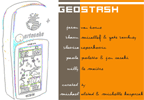
Hide, Seek, Act
Geostash is a public art project that uses the city of Toronto as its inspiration and utilises Global Positioning Technology (GPS) and the web as a means to achieve its creative goals. Geostash takes its cues from the practice of Geocaching (blogged here) - a sort of high-tech treasure hunt that was originally conceived in 2000, and has spread worldwide through websites promoting this activity. Each artist will hide a "stash" somewhere in the city and post the GPS co-ordinates of where the stash is hidden on the Geostash website. The stash may contain a set of instructions requesting an in-situ performance, or could contain objects, materials and a manual to create temporary public art. Once the stashes have all been placed in the city, each participating artist will be randomly assigned another artists' stash to find using a GPS receiver. Once found, the artist will transform the contents of the stash into a performance or ephemeral work of public art.
Date: October 29 - 31, 2004
Location: Various locations in Toronto TBA (check blog for updates)
Participating Artists: Jason Van Horne + Duncan Walker, Shawn Micallef
+ Gabe Sawhney, Slavica Ceperkovic, Paola Poletto + Jon Sasaki, Willy
Le Maitre
Curators: Michael Alstad & Michelle Kasprzak
Posted by newradio at 09:35 AM | Comments (0) | TrackBack
October 19, 2004
Proboscis
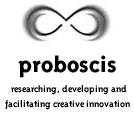
Actors, Agents and Authors
"...Proboscis is trying hasten the arrival of a world where people author as well as consume."
"I believe that this radical shift in information flow and control away from large institutions (both public and private) to ordinary people could have a profound social and cultural impact on the uses and implications of wireless and mobile technologies and mobile technologies in daily life, as well as social and community relations. I believe that the future for our society lies in broadening the capabilities of its members to be actors, agents, and authors, not merely consumers of a culture created by others employed in the 'culture industry.'" Giles Lane quoted by Howard Rheingold in Proboscis Probes Urban Public Authoring. Also, see post on Urban Tapestries.
Posted by jo at 08:48 AM | Comments (0) | TrackBack
Teri Rueb

Connecting via Fluid Space
"The integration of data space and real space through mobile media and location-based systems brings back into circulation a whole host of communication rituals and interaction styles that engage the body, movement and context-sensitive exchanges. With the increasing ubiquity of wireless and mobile media, space is imagined as a Hertzian soup – a space of flows that defies the clear and fast boundaries of visual space and concrete form, instead emphasizing our connectedness in and through the social body." Continue reading Syncopated space – wireless media shaping human movement and social interaction by Teri Rueb.
As a digital artist, Teri Rueb explores the relationship between sound, space and human movement in location-aware installations and large-scale responsive spaces. She exhibits and lectures widely in international venues and is a professor in the graduate Department of Digital Media at the Rhode Island School of Design (RISD).
Posted by jo at 08:30 AM | Comments (0) | TrackBack
October 18, 2004
AudioHyperspace

audio »visions«
The Internet offers to the media as well as to the media artist a new electroacoustic space, abundant with audible live streams, audio on-demand, sound files and increasingly complex interactive audio art. These new possibilities may open up surprisingly new audio »visions« and provoke new strategies of perception. Audio on the Internet has made the boundaries between art, communication and play flexible. This offers a perspective on radio concepts and on radio art designs. AudioHyperspace guides you through the jungle of sound data and explores the development of sonic web art: every month it selects the most interesting audio websites and presents an annotated collection of links to audio and audio art on the web. Some examples of interviews:
Mobile Listening - Electrical Walks
Christina Kubisch in Conversation with Sabine Breitsameter
Sonic Art in Hertzian Space
Teri Rueb in Conversation with Sabine Breitsameter
Birdsong for the Mobile Age
Sadie Plant in Conversation with Sabine Breitsameter
Posted by jo at 12:56 PM | Comments (0) | TrackBack
October 13, 2004
CITYchromosomes

Fixed Points Gathering Impressions
The Stadschromosmen (CITYchromosomes) project gathered thoughts and impressions of particular points around Antwerp and its districts that were shared via SMS. There were 25 ‘text points’, each inviting the submission of impressions about that place. After six months, a selection has been compiled into a booklet that combines the different ‘text points’ and gives an alternative view on Antwerp and its districts. The booklet (in Dutch) is available for download in PDF, plain text and a special version for iPods. By November 15, a complete English translation will also be available under the creative commons license.
"It’s been a fantastic, city-wide...event, put together against the odds and with very little support...by Stefan Kolgen and Ann Laenen of C.H.I.P.S, and including brilliant things like them spending a night turning all the city’s buses into Stadschromosomen text points and leading a walk with 200 recent immigrants round the city, asking them to text in their feelings about the landmarks of their new home town." FishArePeopleToo
STADSchromosomen is CityPoems’ sister project in Antwerp, Belgium, UNESCO's World Book Capital 2004. CityPoems and STADSchromosomen have 'twinned' matching locations in Leeds and Antwerp, to let you use your mobile phone to be in two cities at once.
Posted by jo at 03:05 PM | Comments (1) | TrackBack
Receiver #11

Communication: fitter, happier and more productive
The new issue of receiver is out and has some good reads:
Adam Greenfield on designing with an appreciation for everyday life
Drew Hemment on technologies driven by forces other than economics
Erkki Huhtamo on the cultural history of mobile technologies
Barry Wellman on the importance of the individual in mobile communications
Posted by Anne Galloway on purse lips square jaw, October 13, 2004
Posted by jo at 11:32 AM | Comments (0) | TrackBack
October 11, 2004
Platfrom

Routed Narratives
Platfrom, by Rachel Baker, uses the platform of the mobile phone within a very specific context the train journey. A series of playful SMS messaging scenarios will make a relation between mobile phone and rail network as communication systems. Focusing on privatised, proprietary networks the railway and the mobile phone the project will invert them into opportunities for public and group interaction. It offers moments for train culture and SMS culture to integrate, taking advantage of a journey's incidental nature (delays etc.) with unknown consequences by creating a common gateway between train traveller and static web user and including them both in a narrative along a particular route. The narrative at this stage is dictated by the route from South to North and the contiguous cities and landscape. Read more [PDF]. Also read an essay by Matt Locke.
Posted by jo at 11:52 AM | Comments (0) | TrackBack
October 09, 2004
Glowlab
![]()
a hub for public-space arts
Glowlab is a Brooklyn-based arts lab exploring the nature of urban public space. We produce, document and present multi-media work in psychogeography and public-space arts. We organize events, lectures, collaborative projects and exhibitions, and maintain an online lab at www.glowlab.com. Glowlab is particularly interested in the idea of public space as a creative medium, and we offer the Glowlab website as an online studio/playground where artists and the public can connect and learn.
Glowlab is a highly collaborative venture, and we believe the most exciting work develops when multiple viewpoints are explored. The Glowlab community encourages dialogue on issues ranging from the impact of mobile technologies on urban life to the application of open-source concepts in art production. Whether the approach is political, philosophical or artistic, all those involved with Glowlab share a passion for the creative investigation of the urban landscape. Because our work deals specifically with physical space, we offer a number of offline events to bring our community together. In May 2003 Glowlab produced the first annual psy.geo.CONFLUX, a festival and conference in New York dedicated to current artistic and social investigations in psychogeography, held at community art and activist center ABC No Rio. In May 2004, the second annual Conflux took place at PARTICIPANT INC on the Lower East Side. The event grew to include over 50 artists from around the world who engaged in a wide variety of public-space projects, lectures, performances and audio events over the course of four days. Details about the Conflux can be found at: www.psygeocon.org.
Mission
Glowlab supports the evolution of contemporary psychogeography and serves as a hub for public-space arts. Psychogeography is an open and highly experimental discipline concerned with the ways in which the geographic environment affects emotions and behavior. The Situationists first coined the term psychogeography in the 1950s. They explored the city by engaging in “dérives” or observational drifts with the intention of discovering new perspectives on urban life. Current approaches to psychogeography vary, and include artistic, political, philosophical and scientific work in fields ranging from archaeology and cartography to programming, performance and street art. Glowlab is particularly interested in the psychogeographic elements of contemporary public-space art, including performance, documentary work, film/video and urban research. We aim to bring together these diverse perspectives and engage in dialogue on the evolving methods and practice of psychogeography. To that end, we offer both an online community, in the form of the Glowlab website, and an offline presence in the production of a number of projects and events including experimental walks, a monthly salon and a four-day festival in New York.
Posted by jo at 12:55 PM | Comments (0) | TrackBack
October 05, 2004
Life: a User's Manual, Part 2

Inhabiting Image Spaces
Commissioned by and currently on exhibit at Impakt Online, Life: a User's Manual locates the city of Utrecht as its game board, where every story, every piece stands on its own, but is part of an intricate jigsaw puzzle. Both public physical spaces and private interior spaces contain traces of fragmentary personal [hi]stories tied together by an invisible network of media. How people inhabit the hidden 'image spaces', discovered by a wireless surveillance camera scanner, while at the same time inhabiting physical outdoor spaces, was revealed through the daily practice of walking during the Impakt Festival 2003. The findings of Michelle Teran's walks have been arranged on a map of Utrecht's secret transmissions.
Life a User's Manual is a series of walking performances taking place in different cities (see an earlier post on this site), based around the activity of tapping into the unencrypted transmissions of wireless security cameras using a 2.4 Ghz receiver. In a search for the hidden stories within the city, a walk through the urban streets reveals an invisible network of watched spaces. The unencrypted signal from the camera leaks into public space, making it easily viewable from the street. This puts us in an interesting moment of uncertain inhabitation, of being in two spaces at once.
A tiny fraction of the spectrum of the airwaves has been allocated for public use, as if space and the air are not public already. Taking advantage of this unlicensed part of the spectrum, we have seen an increased used of wireless devices that are all fighting for use of this narrow band. Use of wireless [wifi] networks, cordless phones, bluetooth, and wireless cameras transmitting on this frequency contributes to an already existing invisible world of electromagnetic fields and frequencies that saturate our bodies on a daily basis. It becomes impossible to separate our bodies from the traffic reports, surveillance video, phone calls and pop songs of others. We wear each other's information.
Posted by jo at 11:10 AM | Comments (0) | TrackBack
October 04, 2004
Practice
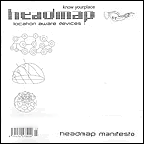
steps beyond the obvious
Esther Polak (Waag Society NL) and Leva Auzina (RIXC, LV) went some way towards rescuing landscape painting. They followed the driver of a milk truck through rural Latvia. He went through his daily routine of collecting up small amounts of milk from local people along a fixed route (in space and roughly in time). They traced the route using GPS units and software from the Realtime Amsterdam (and Riga) project. They took pictures, spoke to the people they met, and recorded interviews. In the end the GPS traces were inadequate. They had to sit down with the driver at the end of the journey with a map and pieces of paper and have him work through the broken traces with a pencil to produce a usable map of the route.
The result of the process was a very different view than photos, or interviews conventionaly produce. They had the drivers route, and maps, and time, and location to anchor point of view differently. They had misty pictures of people carrying milk churns through the countryside. But they also had a rich anchor for the systemic, subjective and spatial context; and more explicit than a literary or filmic narrative conventionally works with. The maps were generated by the people. Both implicitly, and explicitly as the man made sense of the journey he followed (six days a week) with a pencil, and a paper map, and GPS trace fragments.
The follow up thoughts were to trace the milk the next step of the way to the people who ended up drinking it (or consuming it processed into food). This opened up the idea of being able to trace what you consume or produce, right to producer or consumer. And further, open a dialogue between the participants in this cycle of production, distribution and consumption.
From an artists perspective it is now possible to (relatively easily) location stamp digital art work. The place where a work was made, or to which it refers can be logged using GPS for example. Work can be explicitly associated with a place digitally, and then 'found' according to spatial criteria: 'show me all the work associated with this place'. In mobile device terms, work can be accessed actually at a place predetermined by the artist or by the search criteria of the accessor.
How this is interpreted (conceptually and technologically) is up to artists, tool makers, and users.
Filmmakers for example can trace the spatial movements of the camera. Authors can place the next chapter at a new location. Musicians can spontaneously choose a location to perform and generate the audience through a combination of mapping and communications. Festivals, warehouse parties and rave variants have been working on these ideas for many years now, transforming dislocated spaces into gatherings though a disparate range of media.
In Karosta an audience of local people and workshop participants was led out in the dark through the woods to a clearing marked out by a circle of candles where Cheryl L'Hirondelle Waynohtêw was singing. Some way through, the audience (also singing) moved the circle of candles in closer, to make a smaller stage. The candles hinted at location aware, networked lights. You could have a lightweight portable stage that could be followed around, found and mapped on the net. Temporary, portable, visible (both visually and electronically), and findable architectural elements that would fit into a backpack.
Orientating usually requires a conversation with people who know where they are already. These conversations often serve to challenge the inhabitants of a place as to what their place means. Pete Gomes [Parkbench TV, UK] and Gabriel Lopez Shaw [US] found a group of local russian kids to show them around Karosta so that they could film. In the end the group made the film together. The kids found the locations, acted and improvised. Pete and Gabriel logged the locations and showed the kids filmmaking and GPS (the russian kids had long term access to film making and editing equipment through K@2 the Karosta based art project hosting the locative media workshop). Karosta is a very strange place, a borderland between cultures and times. The film explored Karosta in terms of dislocation and location, and its quality as a portal in time and space.
Inside K@2 Jo walsh sketched out an RDF schema for describing located media objects:
"We set out to develop a data structure for 'locative media'. This is partly a holding-place; an open standard format that can be simply re-purposed and re-represented. RDF was chosen because it allows metadata freedom; rather than the prescribed structure of a table with fixed relations to other tables, the underlying model is a graph of connections. 'database' carries the wrong connotations; this is more of a data model, a world model."
from Wilfried Hou Je Bek's database cartography; 'Mapping the patchwork of the street grid as a pattern of connections enables the cartographer to organize them in relativistic space.'
In this locative world model, the atomic unit could be the 'Packet'. A Packet is a state of affairs in space and time. Each Packet can be found at a unique URL on the web. the Packet is tagged with properties; these can be concrete, like latitude and longitude and timestamp, the packet's creator; or they can be abstract, descriptions of moments, feelings, smells. The 'tags' come from shared vocabularies which are published on the web." [see http://locative.x-i.net/karosta/]
All through the workshop participants and locals were focused out towards the surrounding area, trying to corrolate all media generated with location acquisition. Locals and artist going out would take a GPS and try and log location while taking film or photos or writing notes. Using the Waag society's realtime handheld tracking tools and the local GPRS network artists outside the K@2 center could be tracked and there journey traces visulised. Cheryl L'Hirondelle [CA] and Mari Keski-Korsu (FI) were monitored at K@2 after their trace went static for several hours (as they got more and more drunk on a beach with a couple of locals until one of their wives turned up).
Over the course of the workshop a whole sequence of journey traces was generated, enough to build up a subjective map of Karosta.
One night the workshop coordinator Mark Tuters [Locative, CA], with the Latvian electronic musician Voldomars Johansons [LV], and two of the RIXC staff went skinny dipping in the war harbour at 4am. Taking only themselves and a glow stick into the water they returned to find their clothes, and more importantly, the huge symbolic Jungian key to the K@2 centre, had disappeared. Marc turned up at the door with Voldomars behind him and red marks on his neck where one of his RIXC colleagues had tried to strangle him, still carrying the glow stick. Over the next few days all the clothes were found scattered imaginatively throughout the surrounding area.
One of the results of the workshop was a clearer understanding of the practical extant to which location adds a new dimension to media in social, artistic and technical terms. Locative media is a practice and it changes the way users relate to space and their work and each other.
Their were more theoretical aspects to the workshop. A number of the participants had backgrounds in radio.
A discussion between Zita Joyce and Adam Willetts [NL, NZ], radioqualia's Honor Harger and Adam Hyde [UK, NZ], and Ben Russell [Headmap, UK], focused on 'spectrum geography'.
Radio has always had an implicit and explicit connection with geography. For example the power and properties of a transmitter, determines the geographical region it can cover. Radio is a space altering technology, a property that can be articulated and used in many location and community related ways
The electromagnetic spectrum has a geography that can be mapped (see FCC frequency allocation tables), and that can be visualised spatially (see Fiona Raby's 'Flirt' and Anthony Dunne's book Herzian Tales)
Spectrum and space share the fact that they both seemed like finite resources. Now with advances in computing, one piece of spectrum can be divided up almost infinitely. Parallel advances in locative technologies mean that one piece of land can hold an infintite number of digitally mediated constructs and annotations.
Mobile phones which are essentially complexly networked walkie talkies, that use the landline marketing strategy. Instead of selling the open channel, you sell call time on a temporary connection. IP telephony (the word telephony encodes the marketing model) has no reason to follow this model, the infrastructure is already there, no additional exchange or network needs to be built. Open channels are as easy as finite, time limited (and costed) channels. Quake players for example use open channels, for no additional cost. The business model shapes the experience.
The sale of domain names, the primary method of taxing the internet, involves selling something which does not really have a value in the sense that domain names are only vaguely a finite resource and are just an entry in a database.
In the tracking industry there are also parallel examples. 'Geo fences', that is establishing an area and triggering an action if a tracked object enters or leaves that area, are already marketed and sold by some companies despite being a short entry in a database.
Marketers working on location awareness as a business model are going to be working to produce more examples of concrete sounding products which are actually trivial to activate, and involve no (or very little) effort to maintain once the structures are in place to run the larger system. Beyond artificial restrictive walls, marketing also has a simplifying and describing function.
Effective use of locative technologies requires hardware evolution. But also new metaphors that can underpin new interface concepts, that generate new ways of understanding and using the intersection of space, locative hardware and locative software.
Finding innovative uses for locative media probably involves using it for a while rather than endlessly trying to imagine the steps beyond the obvious.
Submitted by locative on Sun, 01/18/2004 - 02:18. Karosta
Posted by jo at 07:21 PM | Comments (0) | TrackBack
Distributed Form: Network Practice
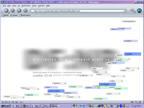
Dominant Spatial Paradigm
Distributed Form: Network Practice, University of California, Berkeley, October 22-24, 2004
"Recent developments in information technology have resulted in the entrenchment of networks and distributed systems as the dominant spatial paradigm, effectively challenging fundamental design issues of autonomy, originality, place, practice and form, which reconfigure disciplines through the implementation of distributed logics and collaborative 'open' practices. As a benchmark, this conference will analyze how the disciplines of art, science and architecture are responding to rapidly changing mobile, wireless, and information-embedded environments.
The conference will be organized around a multidisciplinary framework operating at three different scalar levels: At the Meta level, the conference will first address Form and the Network, raising issues of architectural morphology of and within networked society, by building a provisional history of networked design processes and production.
The second session, Form and Technology, will consider current research on the relationship between experimental digital technologies and emergent form.
The third panel, Micro: Form and Operation, will address theories of operative design strategies, social relationships and bodiless form.
The fourth panel, Mega: Form and Presence, will investigate how larger scale networks and their reconfiguration of time and space are altering professional design practices, while critically considering a logic of connection as the primary site of design."
Posted by jo at 06:22 PM | Comments (0) | TrackBack
October 01, 2004
PERVASIVE AND LOCATIVE ARTS NETWORK (PLAN)
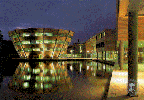
THIS IS THE (PLAN)
A new international and interdisciplinary research network in pervasive media and locative media has been funded as part of the Engineering and Physical Sciences Research Council (EPSRC) Culture & Creativity programme. The network will bring together practicing artists, technology developers and ethnographers with the aim of advancing interdisciplinary understanding and building consortia for future collaborative projects.
The network will stage three major gatherings. Each gathering will have a distinct form and focus: an initial workshop to launch the network and assess the state of the art; a technology summer camp for artists and technologists, including hands-on prototyping sessions using the facilities at Nottingham's Mixed Reality Laboratory; and a major public conference and participatory exhibition as a central component of the Futuresonic 2006 festival in Manchester; as well as a supporting web site and other resources.
CALL FOR PROPOSALS - PLAN Workshop
Submissions are invited to the first of these events, a two day public workshop with papers, demos and discussion sessions. The aim of the event is to launch the network, review the state of the art, bring key players in the field together, and make initial contacts. The event will also aim to identify a range of specific interests that can lead to the formation of sub-groups within the network. Position papers and a summary report will subsequently be published on the network web site.
The workshop will take place in London over two days in the week beginning 24th January 2005. Venue and final dates announced soon.
Please send submissions to ben@open-plan.org by Monday 8th November.
We request that participants seek support for travel and subsistence from their institutions. For participants without institutional affiliation the network shall support applications to funding councils and foundations, please contact us for further details.
THE NETWORK
Pervasive and Locative Arts Network (PLAN) - Enhancing Mobile and Wireless Technologies for Culture and Creativity
This network will draw together computer scientists and engineers who are leading the field in developing pervasive and locative technologies; artists who are using these technologies to create and publicly deploy innovative and provocative experiences; social scientists with a proven track record of studying interactive installations and performances; industrial partners from the creative industries, spanning the arts, television, games, education, heritage, mobile computing and telecommunications sectors; and international partners who are coordinating parallel networks around the world.
NETWORK OBJECTIVES
The network aims to support the formation of a new interdisciplinary research community to investigate how the convergent fields of pervasive media and locative media need to evolve in order to support future cultural and creative activities. Specific network objectives are:
-To review the scope of the research that is currently being carried out in
these fields through a focused workshop, leading to an integrated state-of-the art survey paper.
-To identify the key research issues that need to be addressed in order to further develop pervasive and locative media to support culture and creativity, leading to a series of discussion white papers.
-To seed future projects by bringing artists, scientists and industry together in a creative environment so that they can generate and practically explore new ideas, and also to provide a forum for publicly demonstrating some of these.
-To produce online and offline resources to support researchers, artists, industry and to promote public understanding of this emerging field, including a public website, an online document repository for members and a newsletter and DVD.
NETWORK ACTIVITIES
The network will organise and support a range of activities aimed at growing a research community and generating new collaborative projects between artists and technologists. These will include staging three major research gatherings, producing online and offline resources for fellow researchers and PhD students, and outreach activities targeted at industry.
Gatherings
We will stage three major gatherings. Each gathering will have a distinct form and focus: an initial workshop to launch the network and assess the state of the art; a technology summer camp for artists and technologist, especially PhD students, including hands-on prototyping sessions using the facilities at Nottingham's Mixed Reality Laboratory; and a major public conference and participatory exhibition as a central component of the Futuresonic 2006 festival in Manchester. These major gatherings will be interspersed with more ad-hoc steering and reflection meetings as required by the network participants.
Producing resources
We will produce resources to publicise the network, encourage the exchange of perspectives and discussion, and to provide tutorial support for PhD students, artists and other researchers who wish to break into this area. These will include:
-Online resources: a public website providing access to network information including project deliverables as well as news of forthcoming calls for proposals and conferences, supported by a online document repository where members can upload documents and take part in discussion. The latter will be realised using BSCW or Project Place software.
-Offline resources: a six monthly printed newsletter and a DVD of video
Outreach
The network will reach out to other researchers beyond the initial partners and also to the creative industries. This will include distribution of the newsletter and also staging a series of industry seminars, for example as part of the TI/EPSRC Outreach programme. The network research associate will also carry out a series of site visits to different partners and potential partners in order to learn more about and report on ongoing activities.
BACKGROUND IN SCIENCE AND CULTURE
A new generation of pervasive technologies is enabling people to break away from traditional desktop PCs and games consoles and experience interactive media that are directly embedded into the world around them. And locative media, the combination of mobile devices with locative technologies, supports experiences and social interaction that respond to a participant's physical location and context. Together these convergent fields raise possibilities for new cultural experiences in areas as diverse as performance, installations, games, tourism, heritage, marketing and education.
A community of researchers working in pervasive media, also known as ubiquitous computing, are exploring location awareness as a requirement for the delivery of accurate contextual information. Another community, primarily consisting of informal networks of technical innovators and cultural producers, which identifies its field as Locative Media, is exploring developments in and applications of locative technologies within social and creative contexts. One of the aims of this network is to bring these two communities together, linking academic research initiatives and agendas to key figures and ground breaking developments that are currently taking place outside mainstream academia.
The creative industries are also beginning to take up these opportunities, led by artists who are actively charting out the potentials and boundaries of the new pervasive and locative media. Other cultural sectors have also been exploring the potential of pervasive and locative media including the games industry through commercial examples of locative games played on mobile phones such as Bot Fighters and Battle Machine and also research projects such as ARQuake, Mindwarping, Pirates! and Border Guards. Researchers have also demonstrated applications in heritage and tourism, for example personal tourist guides and outdoors augmented reality displays and as well as in mobile learning experiences and participatory local history mapping projects.
A key characteristic of this research is its interdisciplinary nature, with many of these projects combining practicing artists, technology developers and also ethnographers, whose studies of early experiences that are actually delivered as public artworks have yielded new insights into the ways in which participants experience pervasive media, for example how they (and performers and technical crew) deal with uncertainty of location and connection, and, conversely, new metaphors for engaging in locative media.
However, realising the full potential of pervasive and locative media requires several further developments. First, it is necessary to expand the research community, drawing in new academic partners and also a greater range of partners from the creative industries. Second, it is important to deepen the interdisciplinary relationships between artists, technology developers and social scientists working within and between these two convergent fields. This is not only a matter of reflecting on this relationship, it is also necessary to pursue it in practice, which means forming new collaborations leading to practical projects. Third, we need to clarify and deepen the research agenda for this area, by opening up a variety of research questions, including:
-To what extent does the convergence of pervasive media and locative media signify a commonality of views, definitions and issues in each field?
-What new kinds of cultural applications will become possible through pervasive and locative media? Can we envisage new installations, performances, games and other public experiences?
-Can common design frameworks and tactics help create powerful user experiences? Can we identify and share design guidelines and generate useful abstractions, for example building on recent proposals for deliberately exploiting uncertainty and ambiguity
-What tools are required by creative users, for example that enable them to easily (re)configure an experience to work in different locations or to orchestrate it from behind the scenes. What new research challenges do these embody, for example, how do we visualise the state of the technical infrastructure-networks and sensors-96 or intervene in participants' experiences?
-What methods do researchers use to design and evaluate their experiences? We already see the use of ethnographic studies, audience discussions and even analysis of system logs; how should these be extended and can we share approaches, tools and even datasets to enhance our understanding of experience and design?
These questions, combined with the need to build a broader inter-disciplinary research community, provide the underlying motivations for this network.
INITIAL NETWORK
Project investigators:
Steve Benford, Nottingham (Principle Investigator)
Drew Hemment, Salford
Henk Muller, Bristol
Matthew Chalmers, Glasgow
Michael Sharples, Birmingham
Geraldine Fitzpatrick, Sussex
Christian Heath, Kings College
Jon Hindmarsh, Kings College
Network co-ordinator:
Ben Russell, Headmap/Locative Media Lab
Initial partners:
Marc Tuters, Locative Media Lab
Dennis Del Favero, NSW iCinema
Steve Sayers, NESTA
Toby Barnes, EM Media
Richard Hull, HP Labs
Denny Plowman, City of Nottingham Council
Sara Diamond, Banff Centre
Andrew Caleya Chetty, Metapod
Amanda Oldroyd, BT Exact
Matt Adams, Blast Theory
Nick Southgate, Ricochet TV
Annika Waern, iPerG
Giles Lane, Proboscis
Minna Tarkka, m-cult
Carsten Sorensen, LSE
Angharad Thomas, Salford
Chris Byrne, New Media Scotland
Paul Sermon, Salford
Nina Wakeford, INCITE, Surrey
Posted by jo at 08:20 AM | Comments (0) | TrackBack
September 30, 2004
Teletravel
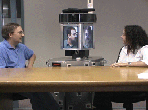
BiReality: Mutually Immersive Mobile Telepresence
BiReality uses a teleoperated robotic surrogate to visit remote locations as a substitute for physical travel. The goal is to create, both for the user and the people at the remote location, the sensory experience relevant for face-to-face interactions. The second-generation system provides a 360-degree surround immersive audio and visual experience for both the user and remote participants, and streams eight high-quality video streams totaling almost 20Mb/s over wireless networking. The system preserves gaze and eye contact, presents local and remote participants to each other at life size, and preserves the head height of the user at the remote location.
Posted by jo at 09:31 AM | Comments (0) | TrackBack
September 29, 2004
The Invisible Train
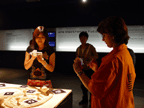
The Invisible Train is a mobile, collaborative multi-user Augmented Reality (AR) game, in which players control virtual trains on a real wooden miniature railroad track. These virtual trains are only visible to players through their PDA's video see-through display as they don't exist in the physical world. This type of user interface is commonly called the "magic lens metaphor".
Players can interact with the game environment by operating track switches and adjusting the speed of their virtual trains. The current state of the game is synchronized between all participants via wireless networking. The common goal of the game is to prevent the virtual trains from colliding. Watch the Quicktime video. Invisible Train will be demonstrated at the International Symposium on Mixed and Augmented Reality (ISMAR 2004) in Arlington, VA.
Originally from waxy. Reblogged by tripp USC Interactive Media Division blog, and by emily on near near future.
Posted by jo at 12:59 PM | Comments (0) | TrackBack
September 26, 2004
physical proximity
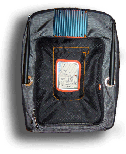
WiFi.Bedouin
Conceived and developed by Julian Bleecker, WiFi.Bedouin is a wearable, mobile 802.11b node disconnected from the global Internet. It forms a WiFi "island Internet" challenging conventional assumptions about WiFi and suggesting new architectures for digital networks that are based on physical proximity rather than solely connectivity. Most significantly, WiFi.Bedouin facilitates the creation of a truly mobile web community.
WiFi.Bedouin is designed to be functional as well as provocative, expanding the possible meaning and metaphors about access, proximity, wireless and WiFi. This access point is not the web without wires. Instead, it is its own web, an apparatus that forces one to reconsider and question notions of virtuality, materiality, displacement, proximity and community. WiFi.Bedouin is meant to suggest that what are often considered two entirely separate realms - virtual and physical worlds - are actually a much more entangled hybrid space. (from the web site)
Posted by newradio at 02:06 PM | Comments (0) | TrackBack
September 25, 2004
Leaders or Followers?
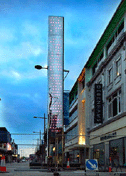
State of the Artists
"Do we drive technology or have we become just passengers? How do we navigate a reality where the lines between the virtual and real are blurred? What is our relationship to our environments, and each other, in an increasingly mediated world?
These questions have been at the heart of electronic art since its birth in the 1960s. It was then that Bell Laboratories Telephone engineer Billy Kluver collaborated with future-minded artists like John Cage and Jean Tinguely on groundbreaking works incorporating, and often critiquing, technology's state-of-the-art. Of course, that tradition continued through the dawn of the digital age and the emergence of the Web. And now it's rising in the vast spectrum of wireless telecommunications." Continue reading David Pescovitz's article at TheFeature.
Posted by jo at 12:06 PM | Comments (0) | TrackBack
September 19, 2004
connect to art
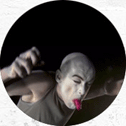
Nokia's Connect to Art Brings Art to Mobile Phones
Connect to Art is a new dimension of art and Nokia's answer to artists' need to find new, innovative channels for artistic expression and ways to reach new and existing audiences by using new methods.
Connect to Art launches with a mobile exhibition featuring three Finnish artists, Stefan Lindfors, Osmo Rauhala and Kati Aberg. Each artist has created audiovisual works of art that draw on the advantages of new media and mobile phones as an alternative channel for distributing art and as a unique environment for experiencing it.
Nokia's vision is life goes mobile. In the future, people will create, distribute and consume digital information and entertainment almost anytime and anywhere, each according to their needs. Already today, features such as news, music and games can be enjoyed in a mobile environment. It is only natural that art will go mobile, too.
Connect to Art will first be introduced in Finland. Starting with visual artists, the concept will later expand also into music. Connect to Art will later make its debut outside of Finland where artists from other countries will be joining in.
Originally posted by emily at textually.org
Posted by jo at 11:14 AM | Comments (0) | TrackBack
September 13, 2004
Mobile Feelings
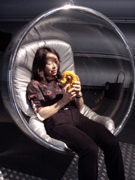
Involuntary Actors
"While mobile phone users are generally glad to embrace the enormous advantages of being reachable any-time and any-where, a reduced sense of privacy combined with the involuntary witnessing of anonymous people's private businesses has created a strange and sometimes awkward form of self-awareness and attention towards others. Mobile phones have transformed ordinary people into actors who narrate their most private details on the theatrical stages of train stations, restaurants, public spaces, streets, meeting areas, and any other social gathering places.
"Mobile Feelings is an artistic project that explores the ambivalence of sharing personal information with an anonymous audience. Instead of communication via voice or images to people we know, Mobile Feelings lets people communicate with strangers through virtual touch and body sensations including smell and sweat using specially designed mobile phones." Read more.
Mobile Feelings, a work by Christa SOMMERER & Laurent MIGNONNEAU, was part of Transmitter, April 21st - May 23rd, 2004; Kunsthalle Dominikanerkirche and around the city of Osnabrück.
Posted by jo at 11:58 AM | Comments (0)
August 28, 2004
ubiquitous computing and the production of space

Call for WiFi.ArtCache Participants
This is a call for contributions to art-technologists interested in contributing to the WiFi.ArtCache during its exhibition at Spectropolis October 1-4, 2004. Deadline for submissions is September 26th.
By simply coding to a provided ActionScript 2.0 API, Flash artists are able to create an interactive experience that changes based on how many people have downloaded their art object, how many people are currently interacting with their art object, or whether their art object is currently in range of the WiFi.ArtCache. Here are earlier posts about WiFi.ArtCache and Spectropolis.
The WiFi.ArtCache is a physical object server containing a standard WiFi 802.11 access point. When exhibited at the Spectropolis event at New York's City Hall Park in Lower Manhattan, the WiFi.ArtCache will contain a storehouse of art objects. Visitors to the event can download these art objects onto their 802.11 equipped laptops and experience the artists' interpretation of location and proximity effects.
Developer documentation and downloads can be found at:
http://wifiartcache.techkwondo.com/overview.jsp
http://artcache.techkwondo.com/overview.jsp
Please send submissions, questions and inquiries to wifiartcache at
techkwondo dot com.
General information about the WiFi.ArtCache concept can be found at:
http://www.techkwondo.com/projects/artcache/
Additionally, the WiFi.ArtCache will contain a generic storehouse of digital ephemera that visitors can upload and download to the server. Scratchy audio, yellowed digital documents, discolored image files and spoiled emails can all be found and dropped off at the WiFi.ArtCache.
WiFi.ArtCache was developed by Julian Bleecker with support from Eyebeam Atelier. This exhibition is sponsored by the Downtown Alliance, NYCWireless, the Lower Manhattan Cultural Council and Spectropolis. Spectropolis is curated by Wayne Ashley, Yury Gitman and Brooke Singer
http://spectropolis.info
http://www.techkwondo.com/projects/artcache
http://www.eyebeam.org
http://www.nycwireless.org
http://www.lmcc.net
Posted by jo at 10:57 AM | Comments (0)
August 25, 2004
more on mobile
Here are a couple of books on mobile phones:
1. Perpetual Contact: Mobile Communications, Private Talk, Public Performance, edited by James E. Katz and Mark Aakhus. This book deals with the impact of mobile phones on contemporary society from Finland to the Phillipines. Published in 2002, its information probably needs an update.
2.The Mobile Connection: The Cell Phone's Impact on Society by Rich Ling. Howard Rheingold calls it "a sound introduction to the social study of mobile phones, arguing among other points that SMS faces a bleak future. Published in 2004.
Earlier posts on the impact of the cell phone include: Ketai and Yo kidda NuOK.
Posted by newradio at 10:08 AM | Comments (0)
August 17, 2004
more on mobile culture
Yo, kidda, nuOK
For anyone interested in the effects of mobile telephones on social and individual life, see Dr. Sadie Plant's 87 page work, on the mobile. In its conclusion Dr. Plant speaks of the use of numbers -- In Mandarin '521' means ' I love you' -- and how "when people from different linguistic backgrounds (non-English speakers) communicate by way of text, the search for the most dense and efficient texts often results in novel combinations of borrowed words and modified codes. Birmingham’s (England) Pakistani teenagers send messages using fusions of Caribbean, Punjabi, and SMS slang: Yo, kidda, nuOK? "Such mixed messages, “ Plant goes on to say, "are likely to become more common as texting spreads, and may even point to the emergence of localized hybrid languages: new textperantos for the mobile age.”
For an earlier post on Japanese use of mobile phones.
Posted by newradio at 10:55 AM | Comments (0)

